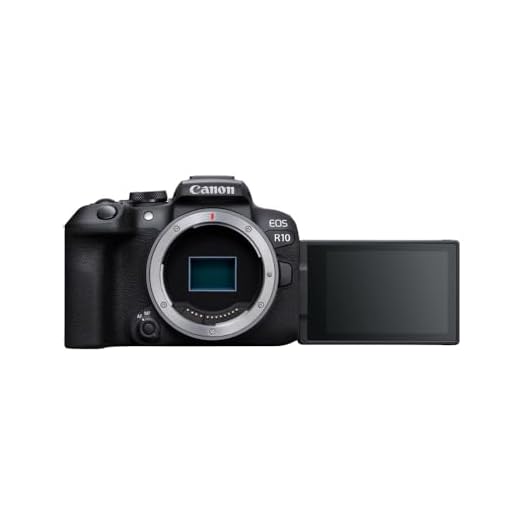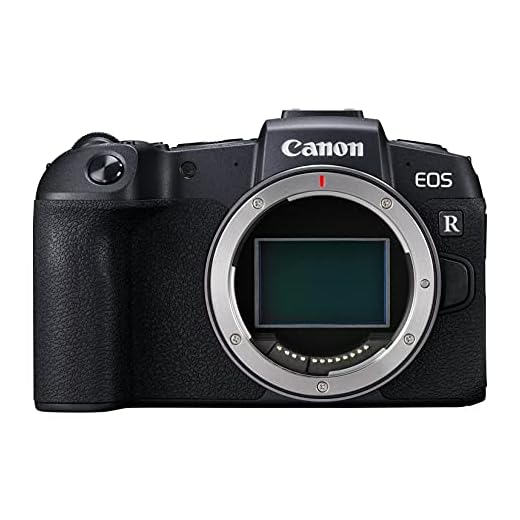Canon EOS R10 vs EOS RP
Two popular choices in the budget mirrorless camera market are the Canon EOS R10 vs EOS RP. Each offers a range of features designed to appeal to different types of photographers, from amateurs to professionals. This comparison will delve into key parameters such as design, optics, videography, battery life, and additional features to help you decide which camera is the right fit for you.


Comparison Table – Canon EOS R10 vs EOS RP
| Feature | Canon EOS R10 | Canon EOS RP |
|---|---|---|
| Design | ||
| TYPE | Mirrorless | Mirrorless |
| VIEWFINDER | Electronic viewfinder (EVF) | Electronic viewfinder (EVF) |
| IS WEATHER-SEALED (SPLASHPROOF) | ✖ | ✔ |
| SCREEN RESOLUTION | 1040k dots | 1040k dots |
| EVF RESOLUTION | 2360k dots | 2360k dots |
| HAS A BUILT-IN FOCUS MOTOR | ✖ | ✖ |
| HAS A FLIP-OUT SCREEN | ✔ | ✔ |
| VIEWFINDER COVERAGE | 100% | 100% |
| SCREEN SIZE | 3″ | 3″ |
| WEIGHT | 426.4 g | 485 g |
| HAS A TOUCH SCREEN | ✔ | ✔ |
| HAS A HOT SHOE | ✔ | ✔ |
| VOLUME | 897.01 cm³ | 788.38 cm³ |
| IS A SYSTEM CAMERA | ✔ | ✔ |
| HAS A FLASH | ✔ | ✖ |
| LOWEST POTENTIAL OPERATING TEMPERATURE | 0 °C | 0 °C |
| MAXIMUM OPERATING TEMPERATURE | 40 °C | 40 °C |
| HAS A TILTING VIEWFINDER | ✖ | ✖ |
| WIDTH | 122.5 mm | 132.5 mm |
| HEIGHT | 87.8 mm | 85 mm |
| THICKNESS | 83.4 mm | 70 mm |
| Optics | ||
| SENSOR SIZE | APS-C | Full frame |
| LENS MOUNT | Canon RF | Canon RF |
| FOCUS POINTS | 651 | 4779 |
| MEGAPIXELS (MAIN CAMERA) | 24.2 MP | 26.2 MP |
| MAXIMUM ISO | 32000 ISO | 40000 ISO |
| MAXIMUM EXPANDED ISO | 51200 ISO | 102400 ISO |
| HAS SENSOR SHIFT STABILIZATION | ✖ | ✖ |
| CONTINUOUS SHOOTING (MECHANICAL) | 15 fps | 5 fps |
| HAS AF TRACKING | ✔ | ✔ |
| HAS PHASE-DETECTION AUTOFOCUS FOR PHOTOS | ✔ | ✔ |
| FASTEST SHUTTER SPEED | 1/4000 s | n.a. |
| HAS MANUAL FOCUS | ✔ | ✔ |
| HAS TOUCH AUTOFOCUS | ✔ | ✔ |
| HAS MANUAL SHUTTER SPEED | ✔ | ✔ |
| HAS A BUILT-IN HDR MODE | ✔ | ✔ |
| HAS A BSI SENSOR | ✖ | ✖ |
| HAS MANUAL EXPOSURE | ✔ | ✔ |
| HAS A TWO-STAGE SHUTTER | ✔ | ✔ |
| HAS A SERIAL SHOT MODE | ✔ | ✔ |
| HAS A CMOS SENSOR | ✔ | ✔ |
| HAS MANUAL ISO | ✔ | ✔ |
| FLASH SYNC SPEED | 1/250 s | n.a. |
| HAS MANUAL WHITE BALANCE | ✔ | ✔ |
| CAN CREATE PANORAMAS IN-CAMERA | ✔ | ✔ |
| EXPOSURE TIME | 30 s | 30 s |
| MAXIMUM ELECTRONIC SHUTTER SPEED | 1/4000 s | 1/4000 s |
| SHUTTER LAG | 0.1 s | n.a. |
| DIGIC VERSION | 10 | 8 |
| HAS A STACKED CMOS SENSOR | ✖ | ✖ |
| PIXEL SIZE (MAIN CAMERA) | 3.72 µm | n.a. |
| CAN COMBINE IMAGE STABILIZATION | ✖ | ✖ |
| Videography | ||
| VIDEO RECORDING (MAIN CAMERA) | 2160 x 30 fps | 2160 x 24 fps |
| HAS PHASE-DETECTION AUTOFOCUS FOR VIDEOS | ✔ | ✔ |
| HAS CONTINUOUS AUTOFOCUS WHEN RECORDING MOVIES | ✔ | ✔ |
| HAS A MICROPHONE INPUT | ✔ | ✔ |
| HAS A SOCKET FOR A 3.5 MM AUDIO JACK | ✖ | ✔ |
| HAS A STEREO MICROPHONE | ✔ | ✔ |
| HAS TIMELAPSE FUNCTION | ✔ | ✔ |
| MOVIE BITRATE | 230 Mbps | 120 Mbps |
| NUMBER OF MICROPHONES | n.a. | 2 |
| HAS A 24P CINEMA MODE | ✔ | ✔ |
| SUPPORTS SLOW-MOTION VIDEO RECORDING | ✖ | ✔ |
| Battery | ||
| BATTERY LIFE (CIPA) | 450 shots | 250 shots |
| HAS A REMOVABLE BATTERY | ✔ | ✔ |
| HAS A RECHARGEABLE BATTERY | ✔ | ✔ |
| HAS A BATTERY LEVEL INDICATOR | ✔ | ✔ |
| BATTERY POWER | 1040 mAh | 1040 mAh |
| Features | ||
| SUPPORTS WI-FI | ✔ | ✔ |
| HAS BLUETOOTH | ✔ | ✔ |
| HAS DUAL CARD SLOTS | ✖ | ✖ |
| HAS PIXEL SHIFT SHOT | ✖ | ✖ |
| SHOOTS RAW | ✔ | ✔ |
| SUPPORTS LOSSLESS COMPRESSED RAW | ✔ | ✖ |
| WI-FI VERSION | Wi-Fi 4 (802.11n) | Wi-Fi 4 (802.11n) |
| SUPPORTS A REMOTE SMARTPHONE | ✔ | ✔ |
| HAS AN HDMI OUTPUT | ✔ | ✔ |
| HAS GPS | ✖ | ✖ |
| HAS FIRST-PARTY SUPPORT FOR LIVE STREAMING | ✔ | ✖ |
| HAS AN ADVANCED HOT SHOE | ✔ | ✖ |
| DXOMARK SENSOR SCORE | n.a. | 85 |
| DXOMARK SPORTS SCORE | n.a. | 2978 ISO |
| DXOMARK LANDSCAPE SCORE | n.a. | 11.9 EV |
| DXOMARK PORTRAIT SCORE | 14 bits | 24.3 bits |
| USB VERSION | 2 | 2 |
| HAS NFC | ✖ | ✖ |
| HAS AN EXTERNAL MEMORY SLOT | ✔ | ✔ |
| HAS USB TYPE-C | ✔ | ✔ |
| BLUETOOTH VERSION | 4.2 | 4.1 |
Design and Build Quality
The Canon EOS R10 and the Canon EOS RP are both mirrorless cameras with electronic viewfinders (EVF), making them compact and easy to carry. However, there are notable differences in their build quality and design features. The Canon EOS RP is weather-sealed, providing extra protection against dust, raindrops, and water splashes, a feature that the EOS R10 lacks. This makes the EOS RP a more rugged option for outdoor photography.
Screen and Viewfinder
Both models offer a screen resolution of 1040k dots and an EVF resolution of 2360k dots, ensuring sharp and clear image previews. They also come equipped with flip-out screens, making them versatile for capturing tricky shots. The screen size for both is 3 inches, but the EOS RP has a slight edge with its higher weight at 485 grams compared to the EOS R10’s 426.4 grams, which may affect handling preference based on user comfort.
Sensor and Image Quality
One of the most critical aspects of any camera is its sensor size and image quality. The Canon EOS R10 features an APS-C sensor, while the EOS RP boasts a full-frame sensor. Full-frame sensors typically provide better low-light performance, dynamic range, and overall image quality, giving the EOS RP an advantage for professional-grade photography. The EOS R10 has 651 focus points compared to the EOS RP’s 4779, offering greater flexibility in selecting the focal point.
Megapixels and ISO Range
In terms of resolution, the EOS RP has a slight edge with its 26.2 MP sensor compared to the 24.2 MP sensor in the EOS R10. Additionally, the EOS RP offers a higher maximum ISO of 40000, expandable to 102400, whereas the EOS R10’s maximum ISO is 32000, expandable to 51200. This makes the EOS RP more versatile in low-light conditions.
Continuous Shooting and Shutter Speed
For action and sports photography, the continuous shooting capabilities are crucial. The EOS R10 can shoot at 15 fps using its mechanical shutter, significantly faster than the EOS RP’s 5 fps. Both cameras support manual focus and touch autofocus, enhancing their usability for capturing fast-moving subjects.
Videography Capabilities
Videographers will appreciate the video recording capabilities of both models. The EOS R10 can record at 2160p at 30 fps, while the EOS RP records at 2160p at 24 fps. The EOS R10 also supports a higher movie bitrate of 230 Mbps compared to the EOS RP’s 120 Mbps, offering better video quality with more details and fewer compression artifacts. Both models feature timelapse functions and stereo microphones, but the EOS RP stands out with support for slow-motion video recording.
Battery Life and Connectivity
Battery life is another critical factor, especially for long shoots. The EOS R10 offers a battery life of 450 shots per charge, significantly higher than the EOS RP’s 250 shots. Both cameras feature removable, rechargeable batteries with a capacity of 1040 mAh and include battery level indicators.
In terms of connectivity, both models support Wi-Fi and Bluetooth, enabling easy data transfer between devices. However, neither has dual card slots or built-in GPS. The EOS R10 supports live streaming via first-party apps, a feature absent in the EOS RP. The EOS R10 also supports lossless compressed RAW shooting, providing higher quality images without increasing file sizes.
Conclusion
Both the Canon EOS R10 and Canon EOS RP offer a range of features catering to different types of photographers. The EOS RP’s full-frame sensor, weather-sealing, and higher ISO range make it an excellent choice for professionals seeking superior image quality and durability. On the other hand, the EOS R10’s higher continuous shooting speed, better battery life, and live streaming capabilities make it ideal for enthusiasts and content creators who need a versatile and robust camera for various shooting scenarios.
Also See:
Canon Unveils the EOS C400 Cinema Camera
Nikon Z6 II vs Nikon Z5 – Comprehensive Comparison
——————————————————————————————————————————————
Techcazt, Tech Magazine. We provide you with the latest news, reviews, and insights on the most cutting-edge technology available today. Whether you’re a hardcore gamer, a tech enthusiast, or just looking for great deals on your favorite gadgets, we’ve got you covered. The articles published in our magazine are intended to provide general information and ideas related to Tech and related topics. We strive to provide accurate and up-to-date information, but readers should always conduct their own research and consult with professionals before making decisions. If you have any comments or suggestions, please comment below. You can also follow us on Facebook, Instagram, and Twitter. Do not forget to give us a LIKE and SUBSCRIBE.



